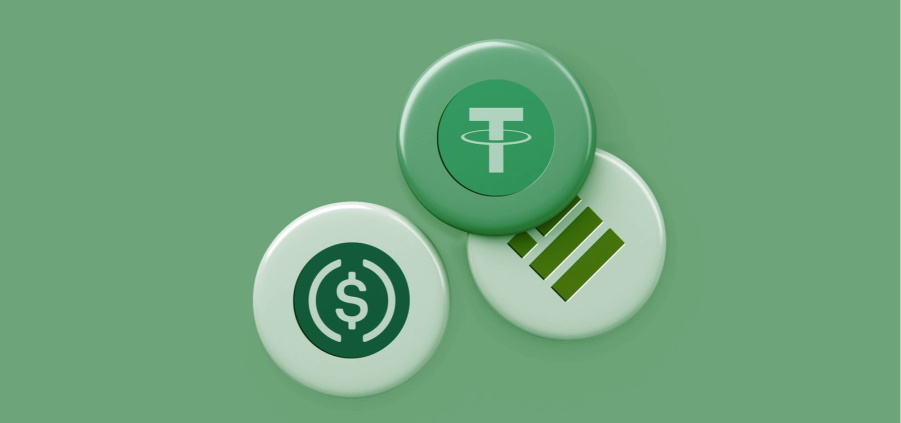- 05/11/2022
- Posted by: Cecil Thomas
- Category: Blockchain for Business

Currency is one of modern society’s most essential building blocks, allowing people to trade goods and services. However, traditional digital currencies have their flaws. For example, fluctuating exchange rates can make it difficult to keep up with market trends, while crypto wallets are vulnerable to hackers. Now a new type of digital currency has emerged: stablecoins. Stablecoins give users an easy-to-use payment system that doesn’t require them to worry about exchange rate fluctuations or cyberattacks on their wallet—promising a more secure way for everyday consumers and businesses alike to store and transfer funds digitally. In this blog post, we’ll explore what stablecoins are, how they work, and why they could revolutionize payments in the future.
How can stablecoins revolutionize traditional payments?
Stablecoins are digital assets pegged to a stable asset, such as the US dollar or other fiat currencies. In this way, their value remains stable regardless of market volatility. This makes them ideal for use in global payments and financial transactions, as they can be transferred quickly and securely across borders with minimal risk.
Moreover, due to their centralized nature and compliance with existing regulations, stablecoins can help increase financial inclusion by providing access to banking services to those who may otherwise not have it. They can also reduce costs associated with international payments by avoiding cross-border fees imposed by traditional payment methods.
Finally, because of their stability and trustworthiness, they offer more security than cryptocurrencies, which can suffer from extreme volatility. This makes them a more reliable option for people sending or receiving money across borders, as they can ensure that the currency’s value remains consistent throughout the transaction.
In short, stablecoins have the potential to revolutionize global payments and financial transactions by providing greater security, reliability, and accessibility. They could provide access to banking services to those who may not otherwise have it, reduce costs associated with international payments, and make sending or receiving money across borders significantly easier and more secure than traditional methods. By doing so, stablecoins could have far-reaching implications for the global economy.

What are the challenges of stablecoins?
One of the biggest challenges faced by stablecoins is maintaining their value. As a fiat-backed assets, they are tied to real-world assets such as government currencies or commodities like gold. These assets carry with them certain risks, such as governmental instability, inflation, and currency volatility. This can make it difficult for issuers to maintain the stablecoin’s value over time. Additionally, due to their backing in real-world assets, stablecoins can require complicated legal agreements between parties, which can be costly and create regulatory compliance problems.
Another challenge with stablecoins is scalability. Since real-world assets back these tokens, their supply cannot easily increase or decrease like other cryptocurrencies whose supply is based on computer algorithms. This makes it hard to match market demand, resulting in supply shortages or excess inventory.
Lastly, stablecoins need to ensure that the underlying assets are secure and properly managed. This is particularly relevant for those coins backed by fiat currencies which require custodial solutions for storing the funds safely. Furthermore, issuers need to develop systems for performing risk assessments on their users as part of anti-money laundering (AML) and know your customer (KYC) regulations. All these steps must be taken to protect users’ funds from theft or fraud.
These are just some of the challenges faced by stablecoins, but they have the potential to provide a great benefit to many individuals and businesses if they can overcome them. As technology evolves and innovation increases, it is likely that these challenges can be addressed in a satisfactory manner.

Current and future trends in stablecoin adoption
Stablecoin adoption is on the rise, and numerous trends indicate this trend is likely to continue. For example, more companies are accepting stablecoins as payment for goods and services. This makes it easier for customers to use these coins and brings added benefits such as lower transaction costs and faster transaction speed. Additionally, more developers are creating applications that make it easier to store and trade stablecoins.
In addition, many institutional investors are beginning to explore the possibilities of investing in stablecoins due to their stability compared to other cryptocurrencies. This could lead to increased demand for different types of stablecoin products over time. Finally, with rising concerns about inflation, central banks may begin issuing their own digital currencies and tokenized versions of fiat currencies, which could further increase the demand for stablecoins.
These trends will likely continue as more people become aware of stablecoins and their potential benefits. As a result, we can expect to see an increase in stablecoin usage and adoption over time. This will ultimately lead to increased liquidity and wider acceptance of these coins, helping to create a strong foundation for the digital economy.
The growth of stablecoins is also likely to spur innovation in other areas, such as DeFi (decentralized finance), allowing developers to create new use cases for these tokens beyond just payments. Ultimately, this could result in more widespread adoption of blockchain technology across different industries and further mainstreaming of cryptocurrencies.
Overall, the future of stablecoins looks bright as more people become aware of their potential and use cases continue to expand. As adoption continues to grow, we can expect to see an increase in liquidity and wider acceptance, helping to create a strong foundation for the digital economy.

